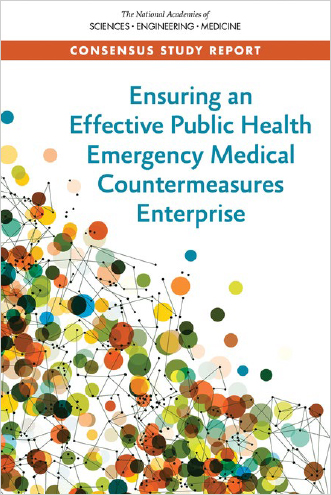About the Standing Committee
In response to the COVID-19 pandemic, the National Academies of Sciences, Engineering, and Medicine (the National Academies) assembled the Standing Committee on Emerging Infectious Diseases and 21st Century Health Threats to help inform the Administration for Strategic Preparedness and Reponse (ASPR) on critical science and policy issues related to emerging infectious diseases and other health threats. Specifically, the standing committee:
- Responds with short notice, and within a specified time frame, to requests from ASPR to assess and consider the science and policy implications of an emerging infectious disease or public health threat;
- Provides a venue and convenes subject-matter experts to enable science and policy discussions relevant to the federal government on emerging issues, research, and activities through in-depth knowledge of ASPR’s programs, goals, and objectives;
- Identifies opportunities to integrate research and scientifically proven guidance into national preparedness and response decision making;
- Considers, identifies, and discusses strategies for addressing misinformation;
- Explores lessons learned and best practices from previous preparedness and response efforts, and identifies opportunities and means to communicate key findings to stakeholders; and
- Supports the planning, development, and work of working groups and separate ad hoc activities in support of ASPR requirements.
The multi-disciplinary standing committee is comprised of 28 experts in emerging infectious diseases, public health, public health preparedness and response, biological sciences, clinical care and crisis standards of care, risk communication, health equity, bioethics, One Health, and regulatory and legal issues. During its second year, the standing committee identified urgent research priorities and contributed to the development of timely, evidence-based guidance on the COVID-19 pandemic, working closely with the Societal Experts Action Network (SEAN). The standing committee’s experts also contributed to a consensus study report on the Public Health Emergency Medical Countermeasures Enterprise (PHEMCE), the nation’s coordinating body to ensure end-to-end medical countermeasure (MCM) preparedness and response.
The wide-ranging portfolio of the standing committee’s work, culminating from its inaugural and most recent year, has illuminated many aspects of the COVID-19 pandemic and how best to respond. Looking ahead, the multidisciplinary experts on the standing committee stand ready to respond to new and continuing challenges of the COVID-19 pandemic, in addition to other emerging infectious diseases and 21st-century health threats. These are challenges in the near and long term, and for individual nations as well as the global community of nations.
Short Consensus Study Report
The standing committee released the following consensus study report in 2021:
Ensuring an Effective Public Health Emergency Medical Countermeasures Enterprise

The interagency group known as PHEMCE is the nation’s sole coordinating body, responsible for ensuring end-to-end MCM preparedness and response. This report provides recommendations from an expert committee for a re-envisioned PHEMCE. Four priority areas of improvement emerged from committee deliberations: (1) articulating PHEMCE’s mission and role and explicating the principles guiding PHEMCE’s operating principles and processes, (2) revising PHEMCE operations and processes, (3) collaborating more effectively with external public and private partners, and (4) navigating legal and policy issues. (1,520 downloads)
The report was mentioned in an NBC News article and NBC Nightly News segment in July 2022, titled “A rare look inside the Strategic National Stockpile—and how it went wrong at the start of the pandemic.” The article and news segment highlight recommendations from the report to improve transparency and to include manufacturers in the decision-making process for the stockpile.
Read the Article
Watch the Video
Rapid Expert Consultations
The National Academies contribute to policy decisions with objective, scientific, evidence-based guidance. The standing committee works closely with SEAN, which enables rapid and actionable responses to social, behavioral, and economic questions related to COVID-19, via an expert network of leaders and institutions that collaborate in response to urgent policy questions and by developing evidence-based guidance to support local, state, and national policy.
The standing committee contributed to four SEAN rapid expert consultations from June 2021 to March 2022, including:
- Addressing Disaster Vulnerability Among Homeless Populations During COVID-19 (June 2021) reviews research on disaster vulnerability, homelessness, the pandemic, and intersecting hazards and disasters. This rapid expert consultation includes considerations for alternative shelter facilities for homeless populations during a disaster, suggestions on how to navigate service reductions and support population-specific needs, and guidance for supporting populations experiencing homelessness in the aftermath of disasters. (425 downloads)
- Short-Term Strategies for Addressing the Impacts of the COVID-19 Pandemic on Women’s Workforce Participation (August 2021) identifies strategies that state and local decision makers can use to assist in short-term recovery efforts for women whose employment status and work experiences have been affected by the COVID-19 pandemic. It includes strategies both for supporting caregiving responsibilities and career development. (598 downloads)
- Communication Strategies for Building Confidence in COVID-19 Vaccines: Addressing 2021 Variants and Childhood Vaccinations (October 2021) affirms the importance of tackling vaccine hesitancy and communicating with parents of children who are eligible to be vaccinated or for whom future eligibility is anticipated. This rapid expert consultation identifies actionable guidance that state and local decision makers can use to communicate with the public to build confidence in and promote the uptake of COVID-19 vaccines. (1,401 downloads)
- Increasing Uptake of COVID-19 Vaccination Through Requirement and Incentive Programs (March 2022) draws on the fields of behavioral economics, health behavior, risk communication, and psychology to identify actionable guidance for state and local decision makers engaged in designing COVID-19 vaccine requirements and incentive programs to increase the uptake of COVID-19 vaccines. (381 downloads)
Meetings
More than 1 year into the COVID-19 pandemic, the standing committee met to consider new priorities regarding the availability of MCM to address the pandemic, the emergence of new variants of concern, and the immediate and long-term impacts of the pandemic on health, well-being, and society. The standing committee’s deliberations focused on identifying medium- and long-term research priorities that could inform preparedness and response in the future across eight working groups: One Health Investigations and Microbiological Characteristics; Patient Care and Infection, Prevention, and Control (IPC); Vaccines and Therapeutics; Public Health Response Management; Health Equity and Community Engagement; Crisis Communication and Misinformation Management; Other 21st Century Health Threats; and Cross-Cutting Themes.
December 9, 2021
Virtual Standing Committee Meeting 3
At this meeting, the standing committee discussed its Statement of Task and explored potential research priorities as a result of the emergence of COVID-19 variants of concern. The standing committee received a briefing on the Omicron variant of concern and discussed issues related to this new variant, including genomic surveillance, vaccines, risk communications, and global coordination. The standing committee then discussed its purpose and strategic direction.
June 17, 2022
Virtual Standing Committee Meeting 4
This meeting gathered perspectives from federal agencies, committee members, and other National Academies’ activities on key research priorities that could inform a medium- to long-term research agenda for COVID-19. Discussions raised key issues related to research coordination, funding, prioritization, and the need for decision-driven, multi-disciplinary research.
Looking Forward
In this ever-evolving pandemic, the standing committee integrates science into national preparedness and response efforts and provides sound, thoughtful, timely, and useful information for the decision makers who are shaping the nation’s response to COVID-19. The standing committee provides a critical venue to enable science and policy discussions relevant to the federal government on emerging issues and stands ready to respond to the COVID-19 pandemic and to other, emerging 21st-century health threats.
Standing Committee on Emerging Infectious Diseases and 21st Century Health Threats
HARVEY V. FINEBERG (Chair)
President, Gordon and Betty Moore Foundation
KRISTIAN G. ANDERSEN
Professor, Department of Immunology and Microbiology, Scripps Research
RALPH S. BARIC
William R. Kenan, Jr. Distinguished Professor, University of North Carolina at Chapel Hill
MARY T. BASSETT
New York State Health Commissioner, New York State Department of Health
GEORGES C. BENJAMIN
Executive Director, American Public Health Association
DONALD BERWICK
President and Senior Fellow, Institute for Healthcare Improvement
RICHARD E. BESSER
President and Chief Executive Officer, Robert Wood Johnson Foundation
R. ALTA CHARO
Professor Emerita, University of Wisconsin Law School
PETER DASZAK
President and Chief Executive Officer, EcoHealth Alliance
JEFFREY S. DUCHIN
Health Officer and Chief, Communicable Disease Epidemiology & Immunization Section, and Professor in Medicine, Public Health—Seattle & King County, and University of Washington, Seattle
ELLEN P. EMBREY
President and Chief Executive Officer, Stratitia
BARUCH FISCHHOFF
Howard Heinz University Professor, Department of Engineering and Public Policy, Carnegie Mellon University
DIANE E. GRIFFIN
University Distinguished Service Professor and Alfred and Jill Sommer Chair, W. Harry Feinstone Department of Molecular Microbiology and Immunology, Johns Hopkins Bloomberg School of Public Health
GIGI K. GRONVALL
Senior Associate, Johns Hopkins Center for Health Security, Johns Hopkins Bloomberg School of Public Health
ROBERT GROVES
Executive Vice President and Provost, Gerard J. Campbell, S.J. Professor, Georgetown University
MARGARET A. HAMBURG
Foreign Secretary, National Academy of Medicine
DAN HANFLING
Vice President, Technical Staff, In-Q-Tel
JOHN L. HICK
Professor of Emergency Medicine, University of Minnesota, Deputy EMS Medical Director, Hennepin EMS, and Medical Director for Emergency Preparedness, Hennepin Healthcare
KENT E. KESTER
Vice President, Translational Medicine, IAVI
PATRICIA A. KING
Professor of Law (Emeritus), Georgetown University Law Center
NICOLE LURIE
U.S. Director, Coalition for Epidemic Preparedness Innovations
JONNA A. MAZET
Vice Provost of Grand Challenges Professor of Epidemiology and Disease Ecology, University of California, Davis
PHYLLIS D. MEADOWS
Senior Fellow, Health Programs, The Kresge Foundation
TARA O’TOOLE
Executive Vice President, In-Q-Tel
ALEXANDRA PHELAN
Assistant Professor, Center for Global Health Science and Security, Department of Microbiology and Immunology, Georgetown University
DAVID A. RELMAN
Thomas C. and Joan M. Merigan Professor in Medicine and Professor, Microbiology and Immunology, Stanford University
MARK S. SMOLINSKI
President, Ending Pandemics
DAVID R. WALT
Hansjörg Wyss Professor of Biologically-Inspired Engineering, Harvard University, Department of Pathology, Brigham and Women’s Hospital
Sponsor
Administration for Strategic Preparedness and Response
Project Staff
Lisa Brown, Senior Program Officer
Shalini Singaravelu, Associate Program Officer
Matthew Masiello, Associate Program Officer
Margaret McCarthy, Research Associate
Andrew M. Pope, Senior Director, Board on Health Sciences Policy (until July 2022)
Clare Stroud, Senior Director, Board on Health Sciences Policy (from July 2022)

ABOUT THE NATIONAL ACADEMIES
The National Academy of Sciences, the National Academy of Engineering, and the National Academy of Medicine work together as the National Academies of Sciences, Engineering, and Medicine (the National Academies) to provide independent, objective analysis and advice to the nation and conduct other activities to solve complex problems and inform public policy decisions. The National Academies also encourage education and research, recognize outstanding contributions to knowledge, and increase public understanding in matters of science, engineering, and medicine.
The Health and Medicine Division (HMD), formerly known as the program unit of the Institute of Medicine, is a division of the National Academies. HMD’s aim is to help those in government and the private sector make informed health decisions by providing evidence on which they can rely. Each year, more than 3,000 individuals volunteer their time, knowledge, and expertise to advance the nation’s health through the work of HMD.
Many of the studies that HMD undertakes are requested by federal agencies and independent organizations; others begin as specific mandates from Congress. While its expert, consensus committees are vital to its advisory role, HMD also convenes a series of forums, roundtables, and standing committees, as well as other activities, to facilitate discussion; discovery; and critical, cross-disciplinary thinking.















